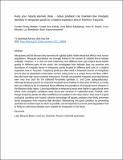Keep your natural enemies close – native predators can maintain low mosquito densities in temporary ponds in a malaria expansion area in Northern Tanzania

View/
Date
2021-11-10Author
Mataba, Gordian
Kafula, Yusuph
Mwaijengo, Grite
Snoeks, Joren
Munishi, Linus
Brendonck, Luc
Vanschoenwinkel, Bram
Metadata
Show full item recordAbstract
Mosquitoes and the diseases they transmit are a global public health threat that affects most human populations. Mosquito abundances are strongly linked to the number of suitable larval habitats available. However, it is still not well understood how different land uses impact larval habitat quality in different parts of the world. We investigated links between land use practices and abundance of mosquito larvae in temporary ponds located in different land uses in a malaria expansion zone in Tanzania. Temporary ponds are often cited as important sources of mosquitoes but are also of substantial conservation concern being home to a unique fauna and flora. Often, they also have high socio-economic importance. Overall, encountered mosquito larval abundances were very low, both for the collected Anopheles gambiae s.l. and Culex quinquefasciatus. Although temporary ponds are important mosquito larval habitats in other parts of Africa, currently they are unlikely to be an important factor affecting the prevalence of mosquito borne diseases in the Manyara study region. Larval abundances in temporary ponds were higher in agricultural areas where more eutrophic conditions were found and minimal in residential areas. Overall, even though temporary ponds are often modified as rice paddies in the rainy season, they were in a good ecological condition and hosted a diverse assemblage of aquatic predators that likely prevented larval mosquitoes from reaching high densities. Maintaining this good condition by preventing pesticide and nutrient input as much as possible, can be important to prevent pond degradation that is likely to make these habitats more suitable for mosquitoes in the future.
URI
https://doi.org/10.1016/j.scitotenv.2021.148606http://dspace.nm-aist.ac.tz/handle/20.500.12479/1270
